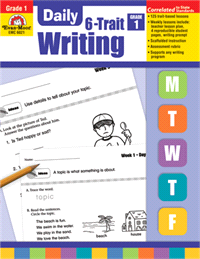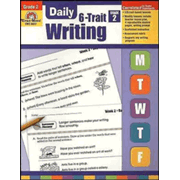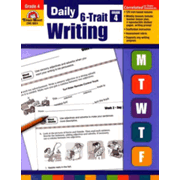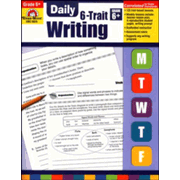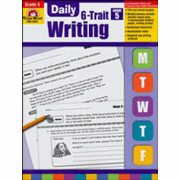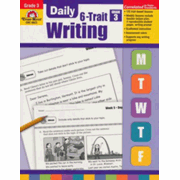The Daily 6-Trait Writing series has books for grades one through six (with the last book covering beyond sixth grade) that thoroughly cover composition skills appropriate for each grade level. The books are very easy to use and don’t require advance preparation. They work best for two or more students since they do sometimes direct students to work with a partner, and they often direct the teacher to use discussion with a group of students to elicit a broad range of examples or ideas. Even, so this series will work very well for one-on-one instruction as long as the parent or teacher follows the teaching instructions and spends time working directly with the student.
I especially appreciate the fact that each course is contained in a single book. Each lesson has a two-page spread with teaching instruction and reduced student pages. This is followed by a four-page spread of reproducible student worksheets. There are four student worksheets per lesson. On the fifth day, students are given a writing prompt or activity to complete based on work they have been doing on the worksheets all week. Worksheets do not have simple activities requiring lower level thinking skills. Students often write sentences on the first four days, so there is a lot of writing as well as critical thinking going on throughout the week.
The “6 Traits” referenced in the title are six key areas that students need to address as they learn writing skills. These are ideas, organization, word choice, sentence fluency, voice, and conventions. Lessons from all grade levels address these six traits, but at increasing levels of difficulty as students move from level to level.
Each course is divided into five units, each of which focuses on one of the first five traits. Each unit takes five weeks to complete. Conventions (grammar, usage, punctuation, and spelling) are taught or reviewed in almost every lesson. While a significant amount of grammar is covered through these lessons, at some point students need more concentration or sequential instruction in grammar. Still, there might be a year or two where the grammar review and application that takes place within one of these courses is sufficient from grammar coverage.
Daily lesson plans are laid out clearly for each day and should be consulted even when the worksheet looks self-explanatory. Often the teaching information includes instruction or an assignment that is not spelled out on the worksheet. The assignment for the fifth day of each week is always given from the teaching pages.
Each book includes a scoring rubric that I think might prove very helpful to parents with little experience teaching writing. It has a grid with the 6 traits down the left hand column. There are five columns to the right. Four of these columns contain boxes with from three to five “comments” in each that might be applied to the student’s writing. Level one comments in the first column fall below the acceptable level. Comments in the boxes for columns two through four reflect increasingly acceptable or excellent work. The fifth column is for the teacher to write a score for each trait. The parent or teacher can simply circle the appropriate comments. Coming up with an actual score is left for the teacher to determine, but it will be clear if a student has many comments circled at a particular level how well the student is doing in comparison to the other levels.
Student worksheets are printed in black and white but have excellent graphic design, illustrations, and plenty of variety that make them relatively interesting. Content is secular, but I have not spotted anything likely to be objectionable to Christians in my limited review.
Note: I reviewed this series since these books are among those included in Timberdoodle's Core Curriculum packages. Daily 6-Trait Writing works very well in that context, but it should also work well along with most other resources of an eclectic nature.




